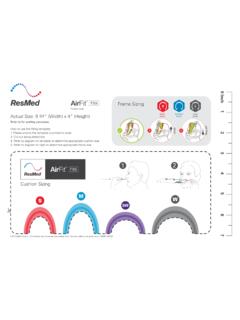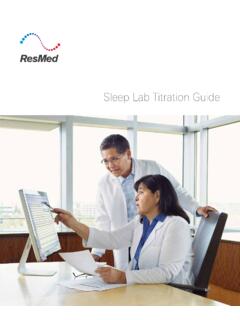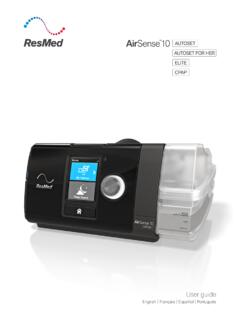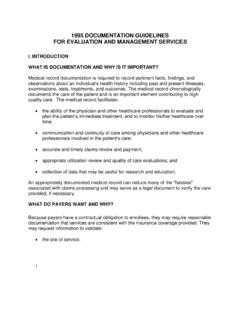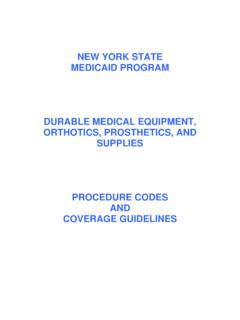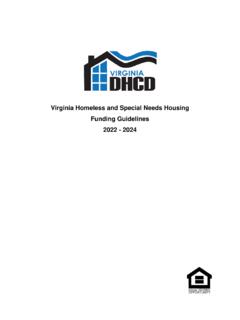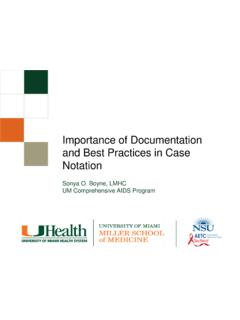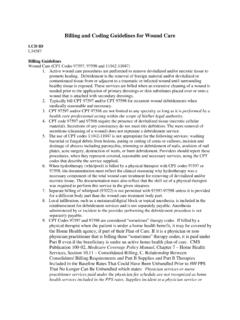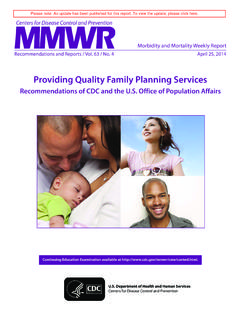Transcription of Home Oxygen Qualifying Guidelines - ResMed
1 Home Oxygen Qualifying GuidelinesCMS revision effective date: September 2016 Qualifying test result: FACE-TO-FACE conducted no more than 30 days prior to the initial Certificate of Medical Necessity (CMN) date. Medical records must document the following: A. Alternative treatments have been considered and deemed clinically ineffective ( medications, inhalers), and the patient suffers from either: - Primary diagnosis (not exhaustive) of severe primary lung disease such as chronic obstructive pulmonary disease (COPD), diffuse interstitial lung disease, cystic fibrosis or bronchiectasis; or pulmonary neoplasm, primary or metastatic, chronic bronchitis or emphysema, or - Hypoxia-related symptoms/conditions that may improve with Oxygen therapy, such as pulmonary hypertension, recurring congestive heart failure due to chronic cor pulmonale or erythrocytosis/erythrocythemia.
2 CMN: The CMN may act as a substitute for a written order if it is sufficiently detailed. (CMN 484). Note: Use Section C to denote the method of administration (cannula, mask, trachea) and frequency of use (continuous, non-continuous, nocturnal). Qualifying blood gas or Oxygen saturation result: A. Testing must be performed while the patient is in a chronic stable state: - As an outpatient, from a qualified testing provider or hospice: within 30 days prior to initial certification, or - As an inpatient transitioning home: within two (2) days prior to discharge. Note: A patient tested in an emergency room is generally not considered to be in a chronic stable state and may need to be tested in a qualified setting.
3 B. The Qualifying blood gas study/ Oxygen saturation test was performed by a physician, qualified provider or supplier of laboratory services that is registered and able to bill for the test, and the necessity for such testing must be documented in the patient s medical record. C. All three Qualifying exercise tests should be performed during the same testing session. Awake & Resting (E1390) Patient is mobile in the home (E1392)SpO2 = 89% and Qualifying secondary diagnosis, or SpO2 88%. Results taken at rest, breathing room & Exercising (E1390) Patient is mobile in the home (E1392)a. SpO2 90% non- Qualifying result taken at rest, breathing room air, andb.
4 SpO2 = 89% and Qualifying secondary diagnosis or SpO2 88%. Results taken during exercise, breathing room air, andc. SpO2 is greater when exercising with O2 as compared to the previous result where the patient was exercising without w/ out OSA (E1390)SpO2 = 89% and Qualifying secondary diagnosis, or SpO2 88% for at least 5 cumulative minutes during a minimum 2 hour recording time, taken during sleep (nocturnal, stationary Oxygen qualification only).Sleeping w/ OSA (E1390)SpO2 = 89% and Qualifying secondary diagnosis, or SpO2 88% for at least 5 cumulative minutes during a titrated, facility-based PSG with a minimum of 2 hours recording time.
5 Patient must meet the following chronic stable state conditions (nocturnal, stationary Oxygen qualification only): Nocturnal oximetry, for the purpose of Oxygen reimbursement qualification, may only be performed after optimal positive airway pressure settings have been determined and the beneficiary is using the positive airway pressure device at those settings. During titration at optimal pressure settings:a. The AHI/RDI is reduced to less than or equal to an average of ten (10) events per hour, orb. If the initial AHI/RDI was less than an average of ten (10) events per hour, the titration demonstrates further reduction in the AHI/RDI.
6 Note: a. Overnight oximetry performed as part of home sleep testing, or as part of any other home testing, is not considered eligible to qualify for reimbursement of home Oxygen and Oxygen Patients diagnosed with obstructive sleep apnea (OSA) may still qualify via the Awake & Resting or Awake & Exercising information is provided as of the date listed, and all coding and reimbursement information is subject to change without notice. It is the provider s responsibility to verify coding and coverage with payors directly. For a full description of the policy, go to For ResMed s reimbursement hotline, dial 1-800-424-0737 and select option 4.
7 2016 ResMed 1019404/2 2016-09 Testing crosswalk and secondary diagnosis definitions:Ongoing coverage :Qualification GroupOximetry SpO2 ABG PaO2 Recertification DueGroup I 88% 55 mm Hgat 12 monthsGroup II=89% and Qualifying secondary diagnosis=56-59 mm Hg and Qualifying secondary diagnosisat 3 months*Group III (Non-Covered) 90% 60 mm HgNon-Covered*Patients initial qualification groupRecertification test timingGroup INo retest result requiredGroup IIMost recent test result obtained between 61st and 90th dayGroup IIINot applicable Arterial blood gas studies may be used in place of oximetry tests. Below are the equivalent values: 2ND FACE-TO-FACE: documentation the patient was seen and re-evaluated by the treating physician within 90 days prior to the date of the recertification CMN (or within 30 days for Group II patients) Retest for Group II only (not required for Group I): Repeat Qualifying blood gas or Oxygen saturation test result Recertification CMN: Secured after 2nd face-to-face and contains Qualifying resultsOnce recertification is achieved, there is no requirement for subsequent retesting based upon changes in blood Oxygen testing results.
8 For example: A beneficiary initially qualifies for group II with an 89% oximetry value. At the 3-month recertification, a result of 89% is obtained. The beneficiary is considered recertified, and subsequent requalification is not required for the duration of the full capped rental. Continued Medical Need (required annually): Any of the following documents dated within 12 months of the date of service under review may serve as documentation : Refill order Change in prescription ( liter flow changes) Updated CMN with appropriate length of need documentation in patient s medical record showing usage of itemQualifying secondary diagnoses include.
9 Dependent edema suggesting congestive heart failure, or Pulmonary hypertension or cor pulmonale, determined by measurement of pulmonary artery pressure, gated blood pool scan, echocardiogram or P pulmonale on EKG (P wave greater than 3 mm in standard leads II, III or AVF), or Erythrocythemia with a hematocrit greater than 56%. Continued Use (required annually): Any of the following documents dated within 12 months of the date of service under review may serve as documentation : Timely documentation in the beneficiary s medical record showing usage of the item Supplier records documenting the request for refill/replacement of supplies in compliance with the Refill documentation Requirements Supplier records documenting beneficiary confirmation of continued use of the rental itemGenerally only one recertification is required, regardless of group classification.
10 The certification will expire when the specified Length of Need (LON) time period elapses. If LON expires, a revised CMN is required to continue coverage .*The Long Term Oxygen Therapy (LTOT) Clinical Trial is investigating Group III and Group II patients without Qualifying secondary testing providers:Under Medicare Part A During a Part A covered stay, payment is bundled so that services rendered are covered under a lump sum payment by Medicare. In this case, Oxygen qualification testing performed in a hospital, nursing facility, Home Health or Hospice, or other covered Part A episode meets the qualified provider standard.


